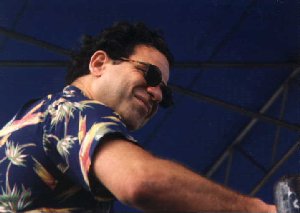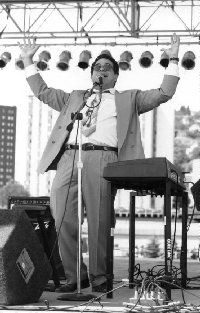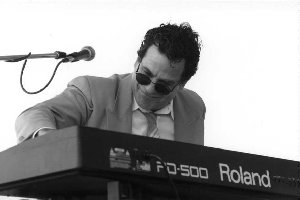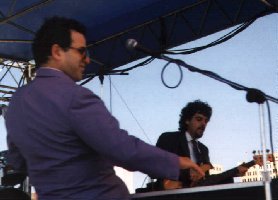


 Photo © 1998 by Ray Stiles All rights reserved |
Born in Brooklyn, NY, April 3, 1951, Mitch Woods first became exposed to music as a child when he would hear piano notes drifting across the street from a nearby mansion into his mother's apartment. Unlike many other children, he actually "wanted" to take piano lessons and once started, showed an immediate aptitude. By the age of eleven, disenchanted with his classical-based lessons, he longed for the musical freedom he heard in jazz and blues. By his teens, during the turbulent 1960's, he was playing clubs in Greenwich Village, taking jazz courses at the University of Buffalo, listening to Otis Spann and Champion Jack Dupree and developing a unique, energetic and exciting piano style of his own. After moving to San Francisco in the early 1970's he discovered the jump-blues of Louis Jordan and quickly became an ardent convert, forming a new band in 1980 called The Rocket 88's.
Woods, an acknowledged master of four distinct styles of piano -- Chicago blues, Kansas City boogie-woogie, West Coast jump-blues and the polyrhythmic accents of New Orleans "second-line" got the opportunity to play with some of his musical heroes when he recorded his 1996 Viceroy album "Keeper Of The Flame."
Ray: Youíre from New York originally right?
Mitch: Originally from Brooklyn, New York.
Ray: How did a Brooklyn boy end up out in California?
Mitch: I was smart (grins). Well my brother moved out there first and I came out when I was about 20 or 21.
Ray: Early 70's
Mitch: Early 70's, 71.
Ray: You had been playing piano for quite awhile at that time already, 11 years?
Mitch: Yeah I started, took classical lessons when I was about 11.
 Photo © 1998 by Tom Asp All rights reserved |
Mitch: Well I liked it but I got to a point... What happened was, my mom was a single mom, she had to go to work so we had a black superintendent in my building and she'd pay him to take us to school, me and my brother as kids. One day he stopped off at a relativeís house and I heard a guy playing boogie woogie piano, and I think I had that in the back of my mind.
Ray: The seeds were planted then.
Mitch: Yeah, then my mom got remarried and fortunately my second father went out and rented a piano and got me to take classical lessons at that time. But then I got bored with it after about 3 or 4 years. I wanted to quite, so we made a deal. (I said) how about if I take jazz and popular lessons so I can learn some of the basics and then I'll keep going.
Ray: Was it easy to pick up the piano, did you have a natural inclination or was it a lot of work?
Mitch: No, I wanted to do it. The classical thing was a little hard, I remember crying when I had to go to a recital, I kind of broke down because I made a mistake. (Laughs) But then once I got into it -- playing rock and roll, jazz, and learning chords, that was natural.
Ray: You were a teenager then?
Mitch: Yeah.
Ray: So what was the progression after that? What lead you to what youíre doing now? Who were you exposed to?
Mitch: The Beetles, we had stated bands when I was about 14 or 15, we were doing Beatles and Stones and a little bit of blues, I remember we had a guitar player who played some Albert King stuff at that time. But actually when I started going with that (blues) was when I went to college at the University of Buffalo, I sat in at a lot of clubs and people mentioned to me that (my playing) sounded like a boogie woogie style. So I went out and bought all the boogie woogie style albums. Albert Ammons, Meade 'Lux' Lewis, Champion Jack Dupree, Pete Johnson, were some of my early guys that I would listen to as much as I could and I would play them over and over again and that's what got me going on boogie woogie. That really was my foundation, blues and boogie piano.
Ray: How about the New Orleans stuff, how did that come about, a different style all together?
 Photo © 1998 by Tom Asp All rights reserved |
Ray: This was after you were out in California.
Mitch: I really didn't have that New Orleans thing down until I started traveling to New Orleans and I started hearing Professor Longhair and I realized oh, thatís where Dr. John got all of his stuff, you know, and I really got into that whole (thing). Actually the first year I was there I sat in at a club called the Mapleleaf, and the owner said why don't you come back on Monday, James Booker is playing. I didn't even know who he was, (he said) you can open the show for him. I came in and played and everybody loved it. Then I heard HIM and I went, WOW, that was incredible. So that was really (the) early exposure to some New Orleans style piano. It really just added another dimension my piano.
Ray: So did you spend time learning that style?
Mitch: Yeah, I would go to New Orleans as much as possible and I got to play with some of the guys who worked with Professor Longhair (like) Johnny Dockovitch on drums, one of the great New Orleans style drummers, George Porter on bass, very early on. They taught me what second line was about. I had no idea, it was scary because unless you're from New Orleans its hard to feel that, so I spent a lot of time... my fiancee, I think, (laughs), is from New Orleans, so I'm spending more time there now.
Ray: Second line is not a real common term, how would you describe that to someone who is not familiar with that terminology?
Mitch: Well, a couple of things. The second line came from the New Orleans funerals where they would march very solemnly to the funerals and then on the way back they would party down, they were a marching band-parade. And there was a line of people following them, the second line, who would start dancing to a certain beat. It was the line of people alongside of the mainline, they were following alongside. The beat was really a combination of a Caribbean, Latin style with rhythm and blues. It's only native to that area because it has those elements of slaves who came from the Caribbean and then the Latin American influence in that port town of New Orleans, mixed in with African American music.
Ray: And they (the musicians) took that, what they were hearing, and incorporated it into the piano.
Mitch: Well Professor Longhair really did that.
Ray: Who else did you get to play with when in New Orleans?
Mitch: Well when I go there I hire a lot of the New Orleans musicians to back me up as much as possible. Irving Charles, who is a bass player for Fats Domino, plays with me a lot when I'm there, Johnny Dockovitch on drums, lot of other guys.
Ray: How did the Chicago piano sound come about for you?
Mitch: I mean Chicago is essential to blues, you cannot play blues and not be influenced by it.
Ray: When did you start listening to that?
Mitch: I listened to Chicago stuff pretty early on, during when I was listening to boogie woogie Iíd listen to Otis Spann. So that was always kind of in the background and then I got to meet James Cotton, he had the same agent as I did so we wound up doing shows together and thatís how I met Cotton. And then I asked him to perform on the CD "Keeper of the Flame."
Ray: When you got to California was that when you were exposed to Louis Jordan and jump-swing music?
 Photo © 1998 by Ray Stiles All rights reserved |

Table of Contents:
Copyright © 1998 by Ray M. Stiles
[Home Page]
[Message Board]
[Calendar]
[Blues Musicians]
[Blues Clubs]
[Blues Jams]
[New Reviews]
[Live Reviews & Interviews]
[CD Reviews]
[Record Labels]
[Jukebox]
[Photo Gallery]
[Memorial]
[Blues Profiles]
[Blues Links]
[Site Description & Updates]
[Site Awards]
[Spotlight Archives]
[Member Directory]
[Featured Website]
[Website Design & Hosting]
All rights reserved. No part of this publication may be reproduced or transmitted in any form or by any means, electronic or mechanical, including photocopy, or any information storage or retrieval system, without permission in writing from the author.